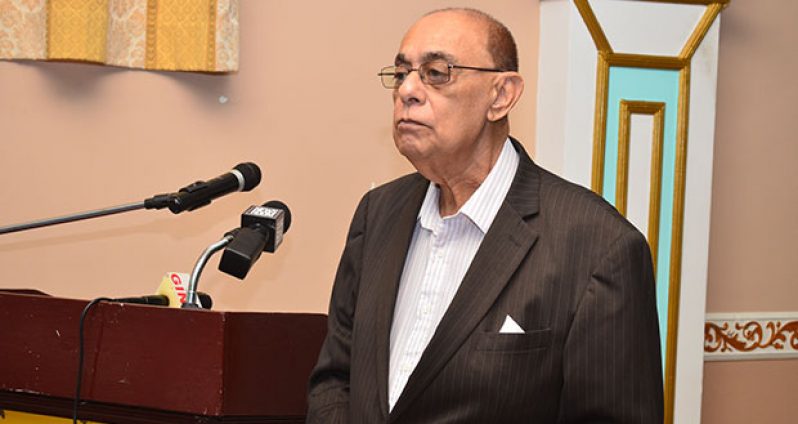By Shirley Thomas
WITH greater emphasis being placed on technical and vocational education and training (TVET) globally, Guyana, through the Council for Technical and Vocational Education Training (CTVET), is looking to garner more financial resources to meet recurrent and capital expenditure.To this end, a Caribbean Development Bank stakeholder consultation meeting to develop a TVET financing strategy for Guyana was held yesterday, with Consultant John Seeram as presenter, and stakeholders coming from from both the private and public sectors, as well as those representing CTVET. The meeting was held at the Regency Hotel Suites and attracted more than 25 representatives.
Outlining that TVET is top priority in many countries, Seeram said it provides nations with a competent and certified workforce possessing knowledge, technical skills and employability competencies in order to drive economic growth and development.
“The image of TVET today is about employment. The workplace today requires well-rounded, well-educated and trained individuals,” Seeram emphasized.
Commenting on the governance and management of TVET, he said the department is headed by an Assistant Chief Education Officer (Technical) working under the Ministry of Education and being responsible for the co-ordination, management and implementation of TVET in secondary and post-secondary institutions.
Other representatives are one each from the Ministries of Social Protection (Board of Industrial Training); Agriculture (Guyana School of Agriculture); Health (Open Door Centre); Presidency (Guyana Mining School and Training Centre Inc.), and Forestry Training Centre Inc.
The CTVET was established by an Act of Parliament on July 2, 2004, and became operational in 2006. Thereafter, it has been working assiduously to achieve the objectives it has been mandated to pursue, and has done so creditably.
Delivery of TVET to students is at the secondary and post-secondary levels, but a recommendation from the floor was that it should also cater for the skills and training needs of those at the primary level.
AREAS OF RESPONSIBILITY
CTVET is responsible for establishing, developing and monitoring schemes to train craftsmen, technicians and engineers needed to sustain and enhance economic growth. And coming out of surveys, the following needs, among others, were highlighted:
* The need for more TVEDT training, especially in specialized areas such as mining
* The need for training institutions in the mining regions: 1, 7, 8, and 9.
* Need for branches of the Carnegie School of Home Economics to be established in the Regions.
* TVET trainers should be well qualified and adequately remunerated
* Succession planning should be in place, and be monitored for training
* There is need for adequate stills in managerial and technical, administrative and clerical, machine operators, drivers (list not exhaustive)

* Mining and construction sectors are in dire need of trained labour
Moreover, since those surveys in 2012 and 2013, there is now increasingly more need for adequate skills for Guyana’s developing petroleum and gas sector. “CTVET/TVET have now to address the skills needed as an urgent training priority,” Seeram submitted.
FINANCING GAP
But while this is so, Seeram submitted that the overarching consideration is the need to identify and find ways of narrowing gaps existing in the financing of CTVET and TVET. Financing of these entities comes through the national budget allocation and private sector contributions and student/trainee fees. The financing needed, he said, is to meet recurrent and well as capital expenditure.
Seeram said that various studies done over the past decade have revealed that there is inadequate funding to meet the needs of CTVET and TVET. “Inadequate allocations for recurrent and capital expenditure have resulted in creating a financing gap,” he argued.
This is exacerbated by the fact that CTVET has not received allocations for capital expenditure needed for a new secretariat building; vehicles to traverse the regions; computers and accessories for the development of information technology; books/journals, etc. for learning centres; and development of staff on the job.
The presenter said that besides the funding provided by the national budget, the private/public sector entities and other interested parties/ individuals should be making more significant contributions towards CTVET and TVET.
Meanwhile, other stakeholders argued strongly that before they could definitively accept that there are gaps in financing, there should be more detailed reporting indicating how much money was initially allocated, what is the status now, and what areas of need were not satisfied. Some of the participants felt that there should be an analysis available for perusal, until such time, they say, it would be difficult to make solid projections. Others, observing that the private sector is already saddled with new taxes, would be reluctant to bear the increased deductions. Still others were in favour of the call to develop a new financing strategy. They contend that expenses are increasing everywhere.
Seeram has said it is intended that such details would be presented at a meeting to be held within another two to three weeks.




.png)









